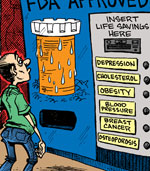Vitamin E Foods - How to Find Foods that are High in Vitamin E
| Share on Facebook | Share on Twitter | Share on Google+ |
Vitamin E is vital for human life, and because our bodies don't make it, we have to get our vitamin E from supplements or food. The most concentrated sources of vitamin E are all animal foods, but animals also have to get their vitamin E from their own food, which are plants. The starting point for most of the vitamin E we get in our food is grain.
Canola, cottonseed, corn, palm, peanut, rice bran, sesame, soy and sunflower oils are great sources of vitamin E, but they do not all contain all the various kinds of vitamin E the body needs.
Sunflower oil, for instance, contains mostly alpha-tocopherol. Corn and soy oils contain mostly gamma-tocopherol.
You would need a mixture of oils from grain and seeds to get a mixture of the various forms of vitamin E your body needs. And you need to consume those oils in an uncooked form. Heating an oil for use in frying evaporates the tocopherols (which are alcohols) or combines them with oxygen, using all their free radical power.
There's also a question of how much vitamin E actually survives the manufacturing process. In Europe, most plant oils are deodorized by a low-temperature process that leaves a distinctive smell in the finished product, but a lot more vitamin E.
In the United States and Canada, most plant oils are heated to higher temperatures and distilled in a more powerful vacuum. The part of the oil that is removed as the cooking oil is deodorized is actually sold to vitamin manufacturers. That doesn't leave a lot of vitamin E in your oil.
Most of the makers of margarine add vitamin E as a preservative. Some add the synthetic dl-alpha-tocopherol. It consists of eight different chemical isomers of vitamin E.
Only one of these isomers can be used by the human body, but the other seven keep the margarine fresh. But if vitamin E is spent on fighting oxidation in a tub of margarine, it won't be available to your body when you eat the margarine.
To get 100 IU of vitamin E your body can actually use, you need to eat 250 grams of margarine. That's 2500 calories, and far more than enough to pack on the pounds!
Wheat germ oil is a great source of vitamin E.
Of all the foods that contain vitamin E, wheat germ oil is the best. You only need about 3 tablespoons (45 ml, or about 50 grams) of vitamin E to get 100 IU of vitamin E, and you'll get all eight forms of vitamin E your body needs in great balance. That's still about 450 calories a day from wheat germ oil alone, and you have to use the oil cold, adding it to salad dressings or smoothies.
Fruits and vegetables offer only very small amounts of vitamin E. Vitamin E is carried in fat. Most fruits and vegetables are inherently low in fat, except for avocados (which most English speakers wouldn't call a "fruit"). You can get 100 IU of vitamin E from five avocados-or 19 cups of spinach, or four pounds (about 2 kilos) of strawberries.
You shouldn't eat these healthy plant foods for vitamin E. They do, however, provide lots of antioxidants that complement that action of vitamin E in your body.
Because nutritionists ignore seven of the eight forms of vitamin E, some of the information you get from nutrition books understates the vitamin E content of food. Rice bran oil and natural palm oil contain tocotrienols. They are a good way to fortify your vitamin E if you are taking a supplement that just contains alpha-tocopherol. You wouldn't know this from reading a nutrition guide, however!
Still, if you need more than 100 IU of vitamin E a day, you will almost certainly have to take a supplement. Natural vitamin E supplements are more easily absorbed by your body, and they are the only way to get seven of the eight forms of vitamin E your body needs.
-
Skin CareMen Skin Care
-
Free ResourcesFree eBooks
-
Half of the modern drugs could well be thrown out of the window, except that the birds might eat them.Dr. Martin Henry Fischer
-
Featured Health Supplement
 ...don't believe those companies or people who say that tablets are not as bio-available. If they are designed and manufactured correctly it is possible to deliver results which are impossible to do with either liquids or capsules.
...don't believe those companies or people who say that tablets are not as bio-available. If they are designed and manufactured correctly it is possible to deliver results which are impossible to do with either liquids or capsules.
-



















